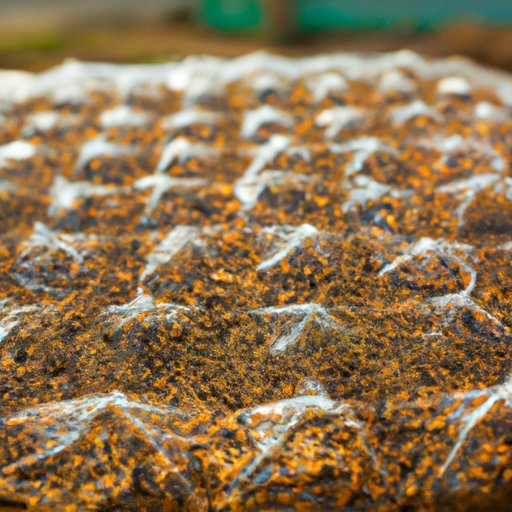Introduction
When it comes to planting grass seed, timing is everything. Knowing when to plant grass seed can make a huge difference in the success of your lawn. Planting at the wrong time of year can lead to poor germination rates, weak seedlings, and disease issues. It’s important to understand the ideal conditions for planting grass seed in order to get the best results.
This article will explore when the best time to put down grass seed is, looking at the benefits of planting in different seasons and examining the optimal climate conditions and soil temperature for planting grass seed.

Analyzing the Ideal Time of Year for Planting Grass Seed
The best time of year to plant grass seed depends on a few factors, including the climate you live in and the type of grass you are planting. Generally speaking, the best times to plant grass seed is either in the spring or the fall. Planting in the spring gives the grass plenty of time to establish itself before the hot summer months, while planting in the fall allows the grass to take advantage of the cooler temperatures and increased rainfall.
When deciding between spring or fall, there are several factors to consider. These include climate conditions, soil temperature, and weather patterns.
Exploring the Benefits of Planting Grass Seed at Different Times of the Year
Planting grass seed in the spring has several advantages. The most obvious benefit is that the temperatures are warmer, which helps the grass to germinate and grow more quickly. Additionally, spring usually brings increased rainfall, which helps the grass to stay hydrated and healthy. Finally, there is generally more sunlight during the spring months, which helps the grass to photosynthesize and produce food.
Planting grass seed in the fall also has its benefits. The most notable advantage is that there is a longer growing season. This means that the grass has more time to become established and develop a strong root system before the cold winter months set in. Additionally, there is less risk of frost damage in the fall, as the temperatures are typically lower than in the spring. Finally, the days are shorter in the fall, which helps the grass to conserve energy.

Looking at the Pros and Cons of Planting Grass Seed in Spring vs Fall
When deciding whether to plant grass seed in the spring or fall, it is important to weigh the pros and cons of each season. Planting in the spring has several advantages, including warmer temperatures, increased rainfall, and more sunlight. However, there is also the potential for frost damage, as well as a shorter growing season.
On the other hand, planting in the fall has several advantages, such as a longer growing season, less risk of frost damage, and lower temperatures. However, there are also some drawbacks, such as decreased rainfall, shorter days, and cooler temperatures.

Examining the Best Climate Conditions for Planting Grass Seed
When choosing the best time of year to plant grass seed, it is important to consider the climate conditions. Temperature, rainfall, and sunlight all play an important role in the success of grass seed. Ideally, the temperature should remain between 65-75 degrees Fahrenheit, with moderate rainfall and plenty of sunlight.
Investigating the Optimal Soil Temperature for Planting Grass Seed
In addition to the climate conditions, it is important to consider the soil temperature. The ideal soil temperature for planting grass seed is between 55-70 degrees Fahrenheit. To test the soil temperature, use a soil thermometer to measure the temperature at a depth of two inches. If the soil is too cold, wait until it warms up before planting.
Conclusion
When it comes to planting grass seed, timing is key. Generally speaking, the best times to plant grass seed is either in the spring or the fall. When deciding between spring or fall, there are several factors to consider, including climate conditions, soil temperature, and weather patterns. Planting in the spring has several advantages, such as warmer temperatures, increased rainfall, and more sunlight; however, there is also the potential for frost damage and a shorter growing season. On the other hand, planting in the fall has several advantages, such as a longer growing season, less risk of frost damage, and lower temperatures; however, there are also some drawbacks, such as decreased rainfall, shorter days, and cooler temperatures.
It is important to remember that the optimal climate conditions for planting grass seed are between 65-75 degrees Fahrenheit, with moderate rainfall and plenty of sunlight. Additionally, the ideal soil temperature is between 55-70 degrees Fahrenheit. By taking these factors into consideration, you can ensure that you are planting grass seed at the best possible time for success.
Conclusion
In conclusion, the best time to put down grass seed depends on a variety of factors, including climate conditions, soil temperature, and weather patterns. Planting in the spring has several advantages, such as warmer temperatures, increased rainfall, and more sunlight; however, there is also the potential for frost damage and a shorter growing season. On the other hand, planting in the fall has several advantages, such as a longer growing season, less risk of frost damage, and lower temperatures; however, there are also some drawbacks, such as decreased rainfall, shorter days, and cooler temperatures. Ultimately, by taking all of these factors into consideration, you can ensure that you are planting grass seed at the best possible time for success.


